Following are profiles of some of our worst invasives. Get to know them!
Each description includes a link to a fact sheet prepared by the Invasive Plant Species Working Group (IPSAWG) or the Ohio Division of Natural Areas and Preserves.
For the complete list of IPSAWG invasives with links to more information, visit their species assessments here.
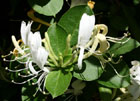
Japanese honeysuckle Lonicera japonica Japanese honeysuckle is a woody semi-evergreen vine with opposite, oval leaves. The vine climbs over vegetation in southern Indiana, forming dense patches that can overtop young forests. Japanese honeysuckle occurs throughout the eastern half of the United States, an area encompassing 26 states. In Indiana, all 92 counties are affected but it is much more aggressive in southern Indiana. IPSAWG Fact Sheet


Asian bush honeysuckle Lonicera maackii, L. tatarica, L. morrowii, L. x bella Asian bush honeysuckles are relatively shade-intolerant and most often occur in forest edges, abandoned fields, roadsides and open wetlands. They will move into forest understories and dominate wherever there has been disturbance. Asian bush honeysuckle is particularly invasive in central and northern parts of Indiana, but is also starting to move into the southern portion. IPSAWG Fact Sheet

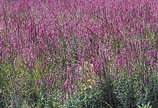
Purple loosestrife Lythrum salicaria Purple loosestrife grows 3-7 feet tall and puts up several spikes of purple flowers in June-July. It spreads aggressively by seed and by rhizome. Even “sterile” cultivars can still produce viable seed. Purple loosestrife has invaded wetlands in northern Indiana, forming pure stands that choke out native vegetation. It has also been found in parts of central and southern Indiana. It is ILLEGAL to buy, sell, or plant purple loosestrife in Indiana. Ohio Fact Sheet

Autumn olive Elaeagnus umbellata Autumn olive is a fast-growing shrub or small tree reaching up to 20 feet tall. It is found in disturbed areas, along roadsides, in pastures, fields and sparse woodlands. It is now found over the eastern half of the United States and in all Indiana counties. IPSAWG Fact Sheet

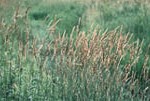
Reed canary grass Phalaris arundinacea var. picta Reed canarygrass can be found in wet meadows, wetlands, marshes, fens, old fields, floodplains, wet prairies, roadsides, ditchbanks, streambanks, lake-shores and shore swales. Any moist, fertile, semi-open to open habitat provides good conditions for this species which spreads aggressively through a thick system of underground stems. Widely planted for forage and erosion control, this grass has taken over large areas of both open and forested wetlands throughout Indiana. It forms monocultures by out-competing all the native wetland plant species. It is found in every county in Indiana, mostly invading wetland community types in the state. IPSAWG Fact Sheet


Phragmites Phragmites australis Phragmites, or Common reed, is especially common in alkaline and brackish environments, and can also thrive in highly acidic wetlands. Commonly found along railroad tracks, roadside ditches, piles of dredge soil and wherever even slight depressions hold water. Phragmites is a grass that reaches up to 15 feet in height and spreads mostly vegetatively forming huge colonies by sprouting new shoots through underground stems. In Indiana, it is common in wetlands in the north and in the brackish water of oil/gas production areas in the southwest. In 2002, Overlease observed it locally abundant in the northern tier of counties and locally abundant along roadsides, ditches, and disturbed areas through much of the state. It has been reported in 56 counties in Indiana. IPSAWG Fact Sheet
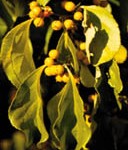

Oriental bittersweet Celastrus orbiculatus Originally, Oriental bittersweet was brought to the United States for cultivation during the middle of the nineteenth century. It is a rapidly spreading deciduous, twining vine. Oriental bittersweet can overrun natural vegetation, forming nearly pure stands in forests, and can also strangle shrubs and small trees, and weaken mature trees by girdling the trunk and weighting the crown. It is now naturalized in 21 of the 33 states where it was introduced, extending from Maine south to Georgia and west to Iowa. In Indiana, it is locally abundant in the southern third of the state and in several counties in northwest Indiana. IPSAWG Fact Sheet
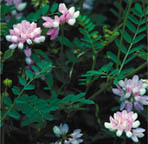
Crown vetch Coronilla varia (also known as Securigera varia) Crown vetch prefers sunny, open areas and was originally planted for erosion control, therefore it is located mostly along roadsides, rights-of-way, open fields, waste grounds and on gravel bars along streams. It is documented as naturalized in all but four U.S. states and is found in every Indiana county. Crown vetch has commonly spread from road shoulder plantings, where it was planted for erosion control. IPSAWG Fact Sheet
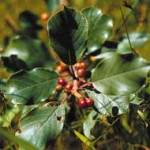

Glossy buckthorn Frangula alnus (also known as Rhamnus frangula) Glossy buckthorn is a tall shrub or small tree that grows up to 20 feet tall, with shiny leaves with smooth edges. Glossy buckthorn tends to occur more often in wetlands and common buckthorn in uplands. Both buckthorns occur in a wide variety of habitats in northern Indiana and spread quickly through natural areas by seed. They take over the under-story and eliminate the diversity of native plants important to wildlife. Glossy buckthorn occurs from Nova Scotia to Manitoba, south to Minnesota, Illinois, New Jersey and Tennessee. In Indiana, it is found primarily in the northern third of the state. IPSAWG Fact Sheet
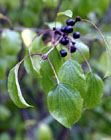
Common buckthorn Rhamnus cathartica Common buckthorn is a tall shrub or small tree that grows up to 20 feet tall, with black fruits and dull green smooth leaves. Glossy buckthorn tends to occur more often in wetlands and common buckthorn in uplands. Both buckthorns occur in a wide variety of habitats in northern Indiana and spread quickly through natural areas by seed. They take over the under-story and eliminate the diversity of native plants important to wildlife. In 2002 (Overlease) reported common buckthorn in DeKalb, Delaware, Elkhart, Fayette, Howard, Huntington, Jay, La Porte, Marshall, Monroe, Montgomery, Noble, Putnam, Ripley, and Steuben. It has also been reported in Clinton, Kosciusko, LaGrange, Lake, and Tippecanoe bringing it to a total of 20 counties in Indiana. Ohio Fact Sheet
